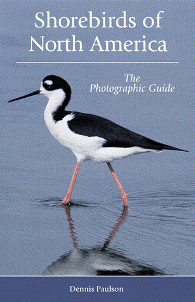Reviewed by Grant McCreary on December 9th, 2006.
This is an identification guide to all the shorebirds of North America, from Canada to Panama. It follows the pattern set by the other guides in the Princeton Photographic Guide series. It starts with an introduction and is followed by the 94 species accounts. The photos are included at the end of each species account.
The introduction is fairly complete, covering the basics of shorebirds including anatomy, variation, behavior, molt, identification, vocalizations, distribution, and conservation. There are four photographs that have been labeled with the various feather tracts and other anatomical parts. These labels are clear and comprehensive. The plumage variation section is especially helpful and necessary with this group of birds. It includes seasonal, sexual, age, geographic, and individual varitaion, feather wear and fading, unusual plumages (albinism, etc), and hybrids. As examples it includes a photos of a leucistic (pale, not compelte albino) Sanderling and Least Sandpiper, and four hybrids.
The species accounts are presented in taxonomic order and consist of 1-2 pages of text followed by up to 16 photographs. The text consists of the following:
- Introduction – a brief intro to the species containing information that doesn’t belong in the following sections
- Size – weight in grams; length in centimeters and inches; bill and tarsus length in centimeters only
- Plumages – generally the largest section, it describes any sexual dimorphism and details the plumages of breeding and nonbreeding adults and juveniles
- Subspecies – lists any subspecies and their breeding and wintering grounds and any identifiable differences
- Identification – tips on separating this species from other similar ones
- Hybrids – if any have been confirmed or suspected
- In Flight – plumage characteristics while in flight
- Voice – flight calls and where appropriate alarm calls and breeding songs
- Behavior – including feeding techniques and flocking
- Habitat – breeding, nonbreeding, and migration
- Range – breeding and wintering areas, migration sites and routes, and vagrant records
Each species has at least one photograph of every plumage and is usually shown in-flight as well. A few species only have one photograph, but while that is unfortunate it should not hinder identification. The short changed species are usually vagrants such as the Jack Snipe, but the American Woodcock inexplicably also has only one photo. Additionally, the Eskimo Curlew only has one picture but that is not surprising since it is the only one believed to exist for this possibly extinct bird.. The photograph format follows the typical pattern for photographic guides, the one The Shorebird Guide deviates from. The photos are mostly the same size, and usually feature a good, close look at a single bird. The photographs are all captioned with the age and sex of the subject where known, as well as the features to look for in the picture. Additionally, in what should be a feature for all photographic guides, they are also captioned with the location and date (month and year) the photo was taken.
A fantastic feature of the guide is the use of the front cover flap to list all the species and their page numbers. It is much easier and quicker to use than a standard table of contents, although there is one of those also.
One thing this guide does not have is range maps. However, even though they would certainly be useful this is not reason enough to overlook this guide since you will undoubtedly have a general field guide that will include them. And shorebirds have a tendency to turn up where they are not “supposed” to be anyway.
This is a very solid guide and would undoubtedly help anyone in the identification of this notoriously difficult group. However, The Shorebird Guide is the better option if you are limited to just one book. But with this group of birds you definitely want all the help you can get.
For more information visit Princeton University Press
Disclosure: I get a small commission for purchases made through links in this post.



Comment